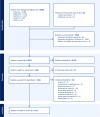Non-mechanical haemodynamic support in acute pulmonary thromboembolism: a scoping review
- PMID: 40824356
- PMCID: PMC12361032
- DOI: 10.1186/s40635-025-00793-1
Non-mechanical haemodynamic support in acute pulmonary thromboembolism: a scoping review
Abstract
Background and aims: Acute pulmonary thromboembolism (PE) may require haemodynamic supportive therapies while appropriate therapies for clot burden reduction are pursued. This scoping review aims to identify the non-mechanical haemodynamic support interventions that have been investigated for the management of acute PE, and to map the available evidence for each intervention.
Methods: An iterative search of MEDLINE, Embase, CINAHL and the Cochrane Library was performed to map all available animal studies, case-series, observational studies, human trials, systematic reviews and meta-analyses that investigate any non-mechanical haemodynamic support in acute PE.
Results: 6,362 unique articles were screened and of the 132 studies that met the eligibility criteria, 98 were animal studies, 31 human studies, and 3 were systematic reviews. Among all studies 57 different agents were found, including 16 among the human studies. 6 agents were investigated across 7 human randomised controlled trials (RCTs) and included inhaled nitric oxide, fluid, furosemide, diclofenac, sildenafil, and epoprostenol, but were limited to intermediate-risk PE and none demonstrated a mortality benefit from the intervention tested.
Conclusion: The evidence to guide clinical practice in the non-mechanical haemodynamic support of PE is severely limited. However, there are numerous candidate agents that could be further investigated. The high-risk group are an understudied population.
Keywords: Afterload; Haemodynamic support; Inotropy; Preload; Pulmonary embolism.
© 2025. The Author(s).
Conflict of interest statement
Declarations. Competing interests: The authors declare that they have no known competing financial interests or personal relationships that could have appeared to influence the work reported in this paper.
Similar articles
-
Sex as a prognostic factor for mortality in adults with acute symptomatic pulmonary embolism.Cochrane Database Syst Rev. 2025 Mar 20;3(3):CD013835. doi: 10.1002/14651858.CD013835.pub2. Cochrane Database Syst Rev. 2025. PMID: 40110896
-
Antidepressants for pain management in adults with chronic pain: a network meta-analysis.Health Technol Assess. 2024 Oct;28(62):1-155. doi: 10.3310/MKRT2948. Health Technol Assess. 2024. PMID: 39367772 Free PMC article.
-
Prescription of Controlled Substances: Benefits and Risks.2025 Jul 6. In: StatPearls [Internet]. Treasure Island (FL): StatPearls Publishing; 2025 Jan–. 2025 Jul 6. In: StatPearls [Internet]. Treasure Island (FL): StatPearls Publishing; 2025 Jan–. PMID: 30726003 Free Books & Documents.
-
Drugs for preventing postoperative nausea and vomiting in adults after general anaesthesia: a network meta-analysis.Cochrane Database Syst Rev. 2020 Oct 19;10(10):CD012859. doi: 10.1002/14651858.CD012859.pub2. Cochrane Database Syst Rev. 2020. PMID: 33075160 Free PMC article.
-
Systemic pharmacological treatments for chronic plaque psoriasis: a network meta-analysis.Cochrane Database Syst Rev. 2021 Apr 19;4(4):CD011535. doi: 10.1002/14651858.CD011535.pub4. Cochrane Database Syst Rev. 2021. Update in: Cochrane Database Syst Rev. 2022 May 23;5:CD011535. doi: 10.1002/14651858.CD011535.pub5. PMID: 33871055 Free PMC article. Updated.
References
-
- Vinay Kumar AA, Aster J (2021) Hemodynamic disorders, thromboembolic disease, and shock. In: Vinay Kumar AA, Aster J (eds) Robins & Cotran pathologic basis of disease. Elsevier, Philadelphia, pp 115–139
-
- Konstantinides SV et al (2020) 2019 ESC Guidelines for the diagnosis and management of acute pulmonary embolism developed in collaboration with the European Respiratory Society (ERS). Eur Heart J 41(4):543–603 - PubMed
-
- Piazza G (2020) Advanced management of intermediate- and high-risk pulmonary embolism: JACC focus seminar. J Am Coll Cardiol 76(18):2117–2127 - PubMed
Publication types
LinkOut - more resources
Full Text Sources
Miscellaneous


